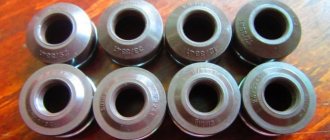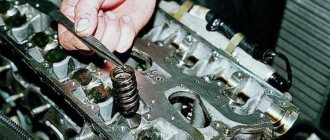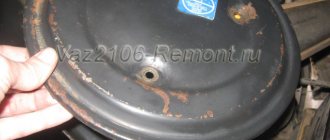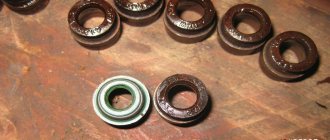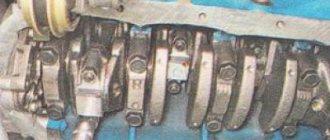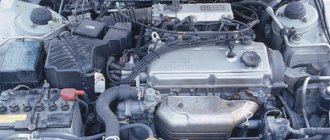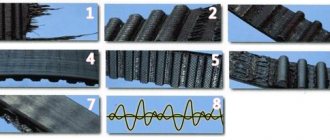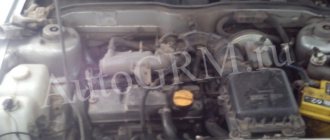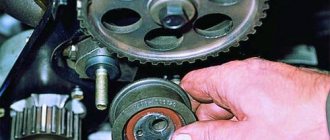Valve seals (VSE) isolate the internal combustion engine from excess lubricant. They are made from a special type of rubber that can withstand loads. However, over time they still wear out, so excess oil gets inside the power plant. This leads to increased vehicle consumption and other problems. Find out how to replace valve stem seals yourself.
Reasons for replacing caps
On average, oil seals last 100 thousand kilometers or more. But this indicator is average; in fact, it all depends on the characteristic features:
- sealing failures - oil consumption increases sharply for every 1000 km;
- changes in the color of the exhaust - when starting or braking, gray, bluish smoke pours out of the muffler;
- coking of spark plugs.
At least one of the listed symptoms will indicate the need for a thorough check and, if necessary, replacement of the valve stem seals.
Do additives help with valve seal leaks?
In the long line of magical products for non-contact engine repair, there are also additives that supposedly eliminate leaks through seals. The principle of operation is clearly explained - they soften the rubber of oil seals or gaskets, restoring their volume and elasticity. If you don’t think any further and buy right away, then that’s enough.
In fact, you have to examine what the deception is in each specific case. If we are talking about MSCs, then their material is such (described above about temperature conditions) that no solvents or ethers that make up the essence of the additives will affect it. Moreover, they will not restore the worn edge and tighten the ring spring.
If you are too lazy to repair it or there are more objective reasons, then there is nothing wrong with stiffened caps. You can drive for a while, especially if the catalyst has been removed from the car.
Then you still have to repair the engine; the valve seal is far from the only part that fails. And when doing repairs, it’s better to buy good products from a reliable manufacturer than to spend the same money on additives, it’s known for whom they were invented.
Replacing caps without removing the cylinder head (Instructions + link to Video)
A special lift is not needed to replace caps in a garage. Below is more information on how to carry out work on a 16-valve 1.8 liter engine. At the same time as this procedure, it is recommended to replace the timing belt, tension/idler rollers, pump and antifreeze so as not to disassemble the car again.
- Unscrew and remove the ignition coil module. On some cars, just pull out the spark plugs.
- Disconnect battery. It is enough to remove the negative terminal.
- Disconnect the electronic control unit to remove the multi-core cable and provide access to the left side of the internal combustion engine and the gas distribution mechanism.
- Remove attachments that interfere with removal of the timing belt.
- Remove the timing belt or chain.
- Release the camshaft gears using a camshaft holder and a socket with an extension. Then you need to remove the plastic protective cover.
- Disconnect unnecessary lines (crankcase exhaust hose, fuel hose, etc.).
- Unscrew the valve covers. It is easier to remove the valve cover bolts with a special pipe wrench or socket.
- Unscrew the camshaft bed fastenings using a Torx hexagon.
- Pull out the beds. Here you need a pry bar, which is inserted into the gap and helps to unstick the stock from the sealant.
- Remove all hydraulic compensators using a magnet. Be sure to sign each pusher so that it is inserted into its original place.
Now all that remains is to remove the MSC.
Video: Replacing valve stem seals without removing the cylinder head
Consequences of driving with worn valve stem seals
Of course, it will be possible to drive with worn valve stem seals for some time. But if the driver ignores the signs listed above, he will worsen the condition of the unit to such an extent that it will eventually exhaust its service life without even completing the required mileage.
When compression in the cylinders drops, in order to maintain the usual driving mode, the driver will have to rev the engine harder. To do this, he will need to use more fuel. In addition to economic considerations, driving with exhausted caps will lead to unstable engine operation.
The power unit will gradually lose idle speed. There will be problems starting the engine, and at traffic lights and railway crossings the driver will need to constantly apply gas. This is distracting, which reduces his response in emergency situations.
When the engine begins to consume a large amount of oil, the motorist has to add lubricant. If its volume drops below the minimum, the engine may experience oil starvation. Because of this, engine repairs will definitely be expensive.
If a car has a catalyst in the exhaust system, this part will quickly fail, since its main task is to clean the exhaust from harmful impurities contained in the smoke. Replacing the catalyst in some cars costs much more than installing new valve stem seals.
In addition to safety (even if the driver has mastered driving skills so much that he can simultaneously perform several actions while driving), the engine will experience additional stress. And due to the increase in carbon deposits inside the unit, its parts will heat up more (due to the additional layer, the thermal conductivity of the metal elements is lost).
The listed factors bring the internal combustion engine closer to a major overhaul. In the case of some budget cars, this procedure is so expensive that it is cheaper to buy another car.
Removing the caps
The work is carried out as follows:
- screw a homemade fitting into the spark plug well;
- connect the compressor, creating pressure in the cylinder - due to the increased pressure in the cylinder, the valve will not fall;
- put the desiccant on, lightly tap it with a hammer and remove the spring with the cracker (we use a magnet again);
- Pull out the oil seal using pliers.
New oil seals are inserted quietly onto the valve, which does not go down, since it is held in place by the pressure from below from the operating compressor. After installing the MSC (you can take the oil seal with tweezers for convenience), you need to press it with a spacer and lightly tap it with a hammer. Replace the spring and dry it. This is how the valve stem seals are replaced without removing the head.
Attention! Before installing a new oil seal, you should install a homemade threader on the valve. A piece of threaded candle will do. It is needed so that the rubber part of the MSC does not lift up during installation. After inserting the oil seal, the homemade element is pulled out.
Necessary tool
Be sure to prepare:
- valve desiccant with nozzles (goat);
- special pliers for removing caps;
- magnet on telescopic antenna;
- hammer;
- tweezers;
- Torx-type hex key;
- shaft holder;
- aluminum tube for pressing in new oil seals;
- a homemade fitting made from a candle - a fitting is welded to one end for threading the compressor hose;
- homemade threader for inserting new MSCs;
- pump (compressor).
And of course, we prepare new consumables: oil seals, valve cover gaskets, belts, rollers, etc.
What is a car's timing belt?
The smooth functioning of the gas distribution mechanism is very important for the smooth operation of the internal combustion engine. The timing belt supplies the combustible mixture to the cylinders and removes exhaust gases from the combustion chamber.
Timely gas distribution is ensured by the movement of the intake and exhaust valves by transferring force to them from the camshaft through cams. In modern car models, the gas distribution mechanism also affects the power and environmental friendliness of the internal combustion engine.
What are the best replacement caps to buy?
MSCs are necessary to seal the gaps between the valve and the guides. For this reason, their quality must be high, otherwise they will quickly wear out and oil will begin to enter the combustion chamber. The best oil seal manufacturers are presented below.
- Nok. The Japanese manufacturer produces high-quality original oil seals, mainly for Toyota and Honda. There are also products for the aftermarket. The service life of these MSKs is guaranteed for 2-3 years or 50 thousand km of vehicle mileage.
- Elring. A German brand that produces excellent products. Oil seals of this form are characterized by elasticity and reliability. True, a number of series were released with inaccurate dimensions, but the manufacturer attributed this to fakes.
- Victor. An American-German holding company that makes very good valve stem seals. Advantages: efficient oil removal, large assortment, originality. The disadvantage is the high price.
It is advisable to replace oil scraper elements at 100-150 thousand km on domestic cars and 200-250 thousand km on foreign cars (Mercedes, Toyota, BMW). And be sure to monitor the signs - oil consumption has increased, you need to check and draw conclusions. The price for replacing valve stem seals without removing the cylinder head at a service station is from 200 to 1000 rubles per set.
The main signs of wear on valve stem seals
How can you determine that the valve stem seals have become unusable and need to be replaced? Here are a few main “symptoms”:
- The engine began to take oil. This is due to the fact that the cap does not collect the lubricant, but rather it enters the cylinder chamber.
- When the driver presses the accelerator, thick bluish or black smoke emerges from the exhaust pipe, which is not caused by cold engine starts in winter (this factor is explained in detail here ).
- Due to strong carbon deposits, the valves do not close tightly. This affects compression, which leads to reduced engine performance.
- During periodic replacement of spark plugs, carbon deposits appeared on their electrodes. Read more about the types of soot in a separate review .
- In a more neglected state, the smooth operation of the engine at idle speed is lost.
- With proper ignition and fuel supply systems, fuel consumption has noticeably increased. At the same time, it is important to make sure that the driver’s driving pattern has not changed towards an aggressive style.
None of the signs on this list are 100% evidence of worn caps. But taken together, they make it possible to determine that the problem is with the valve seals.
In older cars of the domestic auto industry, wear will begin to appear after the car has traveled about 80 thousand kilometers. Modern models use more reliable material, due to which the parts have an increased service life (about 160 thousand kilometers).
When the valve stem seals have lost their elasticity and begin to leak oil, the engine will imperceptibly begin to reduce power after each kilometer traveled.
Recommendations
Now there are many wonderful new products. For example, there are special additives that can restore oil seals. It would seem that everything was filled in, all the worn rubber bands were restored. But in practice this is impossible. According to reviews, additives, on the contrary, increase oil penetration into the cylinders.
What to do if the valve falls into the cylinder?
As I wrote above, in the case of holding the valve with a screwdriver, it is better to bring the piston to top dead center. If the valve tries to fall into the cylinder, it will rest against the piston with its plate and will not fall completely.
In this case, you can get it out with pliers, and if it has sunk deep, a telescopic magnet will help you. It looks like this:
This device is useful in any car and at home. It is often found in hardware stores, but you can also buy it from the Chinese for ridiculous money.
After you lift the valve to its original position, press the screwdriver or rod into it again.
How to replace valve stem seals (oil deflectors) on lower valve engines?
Until 1992, engines with bottom valves were produced in Russia - gas 51 and its stationary and marine modifications. In this engine, the valves are located at the bottom. Most of these engines do not have any oil deflectors; gas 51 certainly does not have them! They are not needed there, but some engines had them, but only on the intake valves.
On these engines it is impossible to change the oil baffles without removing the cylinder head. But these engines are a throwback and the likelihood that you will have to repair them is negligible.
Replacing valve seals without removing the head. — Hyundai Sonata, 2.0 l., 2005 on DRIVE2
Hello everyone! So I got to my Sonya! I replaced the valve seals without removing the head, and removed the balancers! I had been planning to replace the valve seals for at least a year, the oil consumption was not that depressing, but 1 liter. by 1-3 thousand km. sad(depended on the mood and driving style, mostly smoked a lot when starting the engine... Decarbonization with Laurel did not help (And then the long-awaited vacation and the day of HE arrived! It took all 12 hours with disassembly and assembly. There is no point in describing the disassembly process, just like for everyone, nothing new, but there are problems with replacement... As it turned out, the valve seals without removing the head are not so difficult to change, a little inconvenient, uncomfortable in places, but doable), the main thing is a stronger puller, the one I used was very flimsy ( converted from TAZ) and this greatly slowed down the process, I had to periodically straighten it out. It’s very difficult to dry it out alone, but in my case, many thanks to Seryoga, who came with beer after work (since his Sonya was sick) and the work began to boil, we pounced on the valves)...It all took 3-4 hours with smoke breaks and refueling with beer at the crossings))), time flies in good company...PS: it’s better to catch crackers with a neodymium magnet (for example from an old HDD), and for installation, tweezers will help you .Bottom line, oil consumption is not yet clear, but before, when starting the car, there was a smoke screen in the back! Now she’s gone) I’ll drive around and watch...
Photo…
It’s not convenient to dry it out like that!
so correct, the bolt was used from the camshaft fastening
for the first row I selected a shorter bolt
Observations after 4 months... The oil practically does not disappear, practically because... at 6t.k. I had to add 500 grams. I think it burned out on the highways /
Smooth roads everyone!)
Location of valve stem seals in the engine
To find the caps, you need to open the hood of the car and look at the engine. The caps are located directly on the engine valves. Accordingly, as many valves as there are in a car, there are as many caps.
The replacement method and the arsenal of tools required depend on the make of the car and the design of its engine.
Pro Tips: Should I Use Chemical Additives to Restore Oil Seals?
As you know, nowadays there are many additives for restoring oil seals. If you are tempted to use them instead of replacing the caps, remember that there are no miracles in the operation of the power unit. It is impossible to stop the natural wear of parts. Such additives can soften hardened rubber, which would seem to restore the properties of the seals. But, as experience shows, they either have no effect on the rubber or soften it very much, which increases the size of the working edge and significantly increases oil consumption. So it’s better to replace the valve stem seals. The cost of this event will depend on the type of motor. However, you will know for sure that they perform their functions. Additives, alas, cannot guarantee you such an effect. Therefore, you should not try such additives on your car.
Required tools and materials
Self-replacement will require a special tool. The main specific device is a valve desiccant. You will need it to replace the valve seal. Devices and materials:
- sets of socket and socket wrenches;
- extension cord with heads;
- rod and hammer;
- Collet clamp;
- press frame;
- tweezers;
- head gasket;
- a set of new caps;
- sealant.
During the work, it is possible to replace the gaskets under the block and cylinder head. New oil seals are selected for a specific engine model.
This is interesting: Cadillac DTS review
Why is oil intensively consumed?
In a working engine, valve stem seals and rings are responsible for removing residual lubricant from the valve stem and cylinder walls, respectively. At high speeds, the performance of this process decreases, but in general, oil consumption does not exceed the norm prescribed by the manufacturer. For some it is 1 l/10,000 km, for others it is 0.3 l/10,000 km, and still others may not add anything at all between service intervals, since they do not turn the engine above 3,500 rpm.
Naturally, when lubricant consumption suddenly increases, say, to 1 l/1,000 km, and even blue smoke comes out of the exhaust, this is a signal of a violation of the oil scraper functions. There are several reasons for this:
- The oil scraper rings are stuck.
- The caps have become stiff.
- The valve guides are worn out.
Everything would be fine, but these parts are located in different engine modules. So, MSC is a part of the cylinder head, and the rings are a piston element located in the cylinder block. This means that changing everything together is costly, both in terms of time and financially. For example, replacing the caps on a BMW N46B20 according to the A to Z principle will cost 25,000 rubles, and removing the piston caps will cost at least 60,000 rubles. And this is without spare parts.
As a result, it would be nice to determine without disassembly which particular group of parts failed. Whether this is possible is the topic of the next paragraph.

